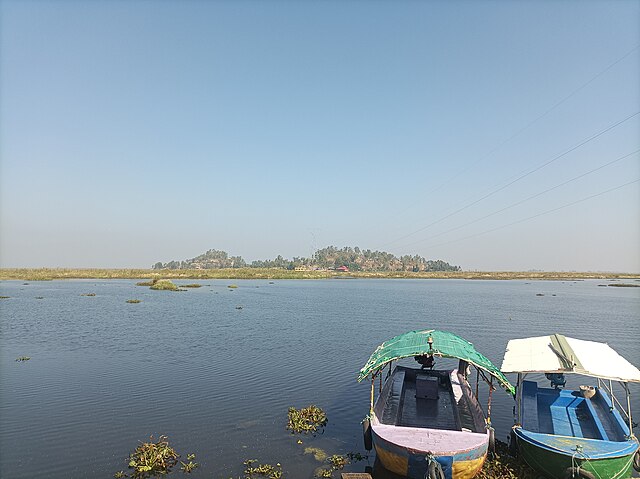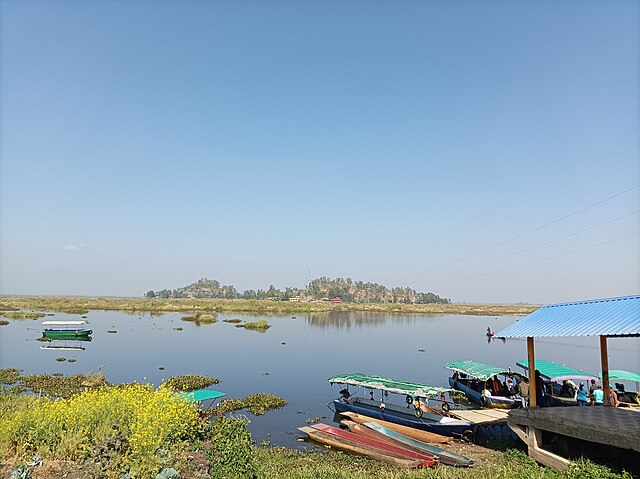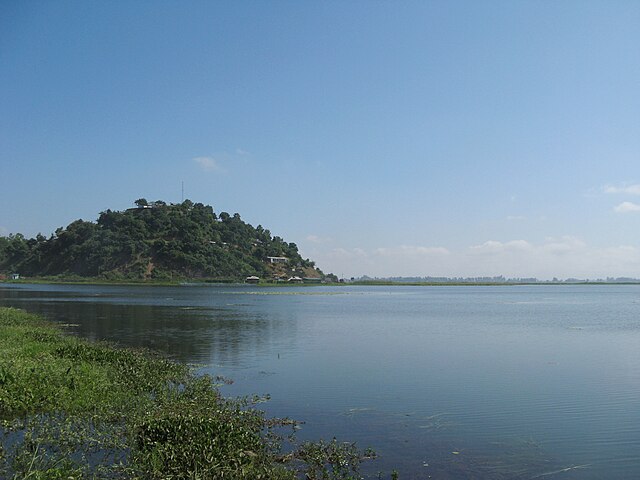Have you ever wondered what it would be like to walk on water? Well, at Loktak Lake in Manipur, you can do something pretty close to that! This extraordinary waterbody isn’t just any ordinary lake – it’s a floating paradise that defies conventional understanding of aquatic ecosystems.
Nestled in the heart of Manipur, Northeast India, Loktak Lake stands as one of the most remarkable natural wonders you’ll ever encounter. Picture this: a vast expanse of water dotted with circular patches of vegetation that float like green islands. These aren’t just any patches – they’re called phumdis, and they’re what make this lake absolutely unique in the world.
What Makes Loktak Lake Special?
The Unique Floating Islands (Phumdis)
The magic of Loktak Lake lies in its phumdis – floating islands made of decomposed plant material, soil, and organic matter. These natural rafts have been forming for centuries, creating a landscape that looks almost otherworldly. Think of them as nature’s own floating gardens, each one a self-contained ecosystem.
These phumdis aren’t static either. They drift with the wind and water currents, constantly reshaping the lake’s appearance. During different seasons, you’ll notice how they cluster together or spread apart, like a slow-motion dance on water. The locals have learned to live with this ever-changing landscape, building their homes and fishing grounds around these floating islands.
What’s truly fascinating is how these phumdis support entire communities. People don’t just fish around them – they actually live on some of the larger, more stable ones. Can you imagine waking up every morning on a floating island, feeling the gentle sway of water beneath your home?
Biodiversity Hotspot of Northeast India
Loktak Lake isn’t just visually stunning – it’s a biodiversity goldmine. The lake supports over 230 species of aquatic plants, 100 bird species, and 425 animal species. It’s like a natural encyclopedia of life forms, each adapted to this unique floating ecosystem.
The interplay between water, floating vegetation, and wildlife creates a complex web of life that scientists are still studying. Every phumdi is a micro-habitat, supporting different species of fish, birds, and aquatic plants. This diversity makes Loktak Lake one of the most important wetland ecosystems in India.
Geography and Location

Where is Loktak Lake Located?
Loktak Lake sits pretty in the Bishnupur district of Manipur, about 48 kilometers from Imphal, the state capital. If you’re looking at a map, you’ll find it nestled in the southeastern part of the state, acting as a natural jewel in Manipur’s crown.
The lake is strategically positioned in the Manipur River basin, fed by numerous streams and rivers flowing down from the surrounding hills. This location makes it the lifeline of Manipur, earning it the nickname “the lifeline of Manipur” among locals.
Size and Physical Characteristics
Covering an area of approximately 287 square kilometers, Loktak Lake is the largest freshwater lake in Northeast India. That’s roughly the size of a small city! The lake’s depth varies seasonally, ranging from 0.5 to 4.6 meters, depending on rainfall and water management.
What’s particularly interesting is how the lake’s size changes throughout the year. During monsoons, it expands significantly, while in dry seasons, some areas become accessible on foot. This dynamic nature keeps both the ecosystem and local communities constantly adapting.
The Ecosystem of Loktak Lake
Flora and Fauna
The ecosystem of Loktak Lake reads like a naturalist’s dream journal. The floating phumdis support a rich variety of plant life, from water hyacinth to various grasses and sedges. These plants don’t just float aimlessly – they form complex root systems that filter the water and provide shelter for countless aquatic creatures.
Endemic Species
The crown jewel of Loktak’s biodiversity is the Sangai deer (Rucervus eldii eldii), also known as the dancing deer. This endangered species is found nowhere else in the world except in the floating grasslands of Loktak Lake. With fewer than 300 individuals remaining, seeing a Sangai is like witnessing a living treasure.
The lake also hosts several endemic fish species that have evolved specifically to thrive in this floating ecosystem. These fish have adapted unique feeding and breeding behaviors that match the rhythm of the floating islands.
Migratory Birds
Every winter, Loktak Lake transforms into a bustling airport for migratory birds. Over 100 species of birds make this their temporary home, including several rare and endangered species. You might spot everything from elegant herons to colorful kingfishers, each playing their part in the lake’s ecological symphony.
The sight of thousands of birds taking flight at dawn is something that stays with you forever. It’s like watching nature’s own air show, with choreography that puts human performances to shame.
Keibul Lamjao National Park
The southern part of Loktak Lake houses the world’s only floating national park – Keibul Lamjao National Park. Spanning 40 square kilometers, this unique protected area consists entirely of floating phumdis. It’s the last natural habitat of the Sangai deer and represents one of the most unusual conservation success stories in the world.
Walking through (or should we say floating through?) this national park is an surreal experience. The ground beneath your feet gently sways, reminding you constantly that you’re walking on water. It’s nature’s own magic carpet ride!
Cultural and Historical Significance
Local Communities and Their Connection
For the people of Manipur, Loktak Lake isn’t just a body of water – it’s deeply woven into their cultural fabric. Local communities have lived around and on the lake for generations, developing a unique lifestyle that’s perfectly adapted to this floating world.
The Meitei community, in particular, has countless legends and stories connected to the lake. They believe the lake is sacred, home to various deities and spirits. This spiritual connection has helped preserve the lake’s ecosystem for centuries, as local customs traditionally prohibited activities that could harm the water or its inhabitants.
Traditional Fishing Practices
Fishing on Loktak Lake is an art form passed down through generations. The local fishermen have developed unique techniques that work with the floating phumdis rather than against them. They use traditional boats called “hiyang hiren” and fishing methods that ensure sustainable harvesting.
These fishermen don’t just catch fish – they’re the lake’s guardians, understanding its rhythms and changes better than any scientist. Their traditional ecological knowledge is invaluable for conservation efforts and sustainable management of the lake’s resources.
Environmental Challenges

Pollution and Degradation
Like many precious ecosystems worldwide, Loktak Lake faces serious environmental challenges. Agricultural runoff, domestic sewage, and industrial waste have begun affecting the lake’s water quality. The proliferation of water hyacinth, while natural, has reached problematic levels in some areas.
The construction of the Ithai Barrage in 1983, while helping with flood control and power generation, has also altered the lake’s natural flow patterns. This has affected the seasonal rise and fall of water levels that many species depend on for their life cycles.
Climate Change Impact
Climate change is throwing new challenges at this delicate ecosystem. Changing rainfall patterns, extreme weather events, and shifting temperatures are affecting both the floating phumdis and the species that depend on them. The Sangai deer, already critically endangered, faces additional pressure from these environmental changes.
Conservation Efforts
Government Initiatives
The Government of Manipur, along with central authorities, has launched several initiatives to protect Loktak Lake. The Loktak Development Authority was established specifically to coordinate conservation efforts and sustainable development around the lake.
Recent projects focus on controlling pollution, managing water hyacinth, and restoring degraded areas. There’s also increased emphasis on involving local communities in conservation efforts, recognizing that their traditional knowledge and practices are crucial for the lake’s survival.
Community-Based Conservation
Local communities are increasingly taking the lead in conservation efforts. Fishing cooperatives are implementing sustainable practices, while village committees are monitoring water quality and reporting environmental concerns. This grassroots approach is showing promising results.
Young people from local communities are also becoming environmental ambassadors, combining traditional knowledge with modern conservation techniques. They’re the bridge between ancient wisdom and contemporary science.
Tourism and Recreation

Best Time to Visit
The ideal time to visit Loktak Lake is during the post-monsoon and winter months, from October to March. During this period, the weather is pleasant, the floating islands are at their most stable, and migratory birds add extra charm to the landscape.
Each season offers a different perspective of the lake. Monsoons bring lush greenery and dramatic skies, while winter offers clear views and comfortable temperatures for extended exploration.
Activities for Tourists
Visitors to Loktak Lake can enjoy boat rides through the floating islands, bird watching, photography, and visits to Keibul Lamjao National Park. The unique experience of walking on floating ground in the national park is something you simply can’t get anywhere else in the world.
Local guides offer insights into traditional fishing methods, local culture, and the lake’s ecology. These interactions provide visitors with a deeper understanding of this remarkable ecosystem beyond just its visual appeal.
How to Reach Loktak Lake
Getting to Loktak Lake is relatively straightforward. The nearest airport is Imphal Airport, about 53 kilometers away. From there, you can hire a taxi or take a bus to reach the lake. The journey offers beautiful views of Manipur’s rolling hills and valleys.
If you’re traveling by train, the nearest railway station is in Dimapur, Nagaland, about 215 kilometers away. From Dimapur, you can take a bus or taxi to Imphal and then proceed to the lake.
Accommodation Options

While there aren’t luxury resorts right on the lake, several comfortable options exist in nearby areas and Imphal. Some local communities offer homestay experiences, which provide authentic insights into life around the floating lake.
For those seeking a more immersive experience, floating huts on stable phumdis offer overnight stays. Imagine falling asleep to the gentle lapping of water and waking up surrounded by floating islands – it’s an experience that redefines the meaning of waterfront accommodation!
Tips for Responsible Tourism
When visiting this ecological treasure, remember that you’re entering a delicate ecosystem. Avoid disturbing wildlife, don’t litter, and respect local customs and traditions. The floating islands might look sturdy, but they’re actually quite fragile ecosystems that can be easily damaged.
Support local communities by hiring local guides, buying local products, and staying in community-run accommodations. Your tourism dollars can directly contribute to conservation efforts and provide sustainable livelihoods for local people.
Conclusion
Loktak Lake stands as a testament to nature’s incredible creativity and resilience. This floating paradise offers us a glimpse into a world where water and land exist in perfect harmony, where communities have learned to live with rather than against natural processes, and where every sunrise brings new configurations of floating islands.
As we face global environmental challenges, Loktak Lake reminds us that unique ecosystems require unique conservation approaches. The lake’s survival depends not just on government policies or scientific research, but on the continued involvement of local communities who have called this floating world home for generations.
Whether you’re a nature enthusiast, a photographer, a cultural explorer, or simply someone seeking extraordinary experiences, Loktak Lake offers something truly special. It’s a place where you can literally walk on water, witness endangered species in their natural habitat, and experience a way of life that exists nowhere else on Earth.
The floating jewel of Manipur awaits your visit, ready to share its secrets and show you that sometimes, the most incredible places on Earth are also the most fragile. Come, experience the magic, but come as a responsible visitor who understands that preserving this wonder is our collective responsibility.
Frequently Asked Questions
1. What makes the islands in Loktak Lake float? The floating islands, called phumdis, are made of decomposed organic matter, soil, and vegetation that has accumulated over centuries. They have a lower density than water due to trapped air and gases from decomposition, which makes them naturally buoyant. These aren’t artificial constructions – they’re entirely natural formations that have evolved over time.
2. Is it safe to walk on the floating islands? Yes, it’s generally safe to walk on the larger, more stable phumdis, especially in Keibul Lamjao National Park where designated walking areas have been established. However, you should always go with experienced local guides who know which areas are stable and safe. Some smaller or newer phumdis might not support human weight.
3. What is the best way to see the endangered Sangai deer? The best chance to spot Sangai deer is by visiting Keibul Lamjao National Park early in the morning or late afternoon when they’re most active. Hiring a local guide significantly increases your chances, as they know the deer’s preferred grazing areas and movement patterns. Remember to maintain distance and avoid disturbing these critically endangered animals.
4. Can tourists stay overnight on the floating islands? Yes, some stable phumdis have been developed with basic floating accommodations, including traditional huts. These overnight stays offer a unique experience of sleeping on water, but facilities are basic. Most tourists prefer staying in nearby guesthouses or Imphal and taking day trips to the lake.
5. How has the construction of the Ithai Barrage affected the lake? The Ithai Barrage, built in 1983 for flood control and hydroelectric power, has significantly changed the lake’s natural water level fluctuations. While it provides benefits like electricity and flood protection, it has also altered the ecosystem’s natural rhythms, affecting fish breeding cycles and the formation of new phumdis. This is one of the major conservation challenges the lake currently faces.

